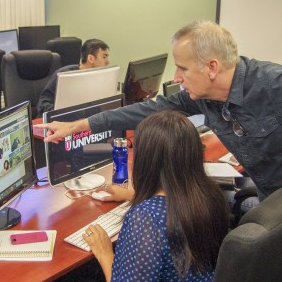CM/EMDA 399 Reinventing College. Sounds high minded, and it is. I participated as a student and a journalist and came away with some interesting ideas.
The course was modeled after the ground-breaking project, d.school, at the Institute of Design at Stanford. The class consisted of 13 students of varying backgrounds, genders and ethnicities, one mathematics professor, and a member of the SOU administration. We were tasked to create new educational models for the future of higher education using a method called visual thinking, which was developed by a Portland firm called XPLANE, “I have always been interested in bringing their methods into the classroom to give students a taste of real world, cutting edge practices, which are utilized by fortune 100 firms such as Intel and Microsoft,” said Palmer.
Initially, we performed some prior research into what various universities and other higher educational groups, such as private schools, mentorship programs, and Massive Open Online Courses (MOOC’s) are doing to create new learning organizations in our time of decreased budgets and increased competition. The programs we researched included the Minerva Project, Arizona State University, the Theil Fellowship, and the revolutionary edX programs, among others. We also studied various brainstorming methods, which included visual learning, design sprints, and a plethora of brightly colored sticky notes. Each participant also submitted a short essay on a particular issue or incident, here at SOU, which impacted their educational path. We were then prepared for the workshop.
The first day we were separated into small groups of two or three, and were sent out to survey other students. We asked questions to discover students needs and desires in their educational experience. We taped photos of them on the wall, and then used sticky notes to post their responses to our questions. We categorized the responses from our students, and reorganized them into specific categories based on their responses. The walls of the room were soon covered with color–and valuable insights.
On day two, we combined our efforts and formed four individual groups. We re-organized the information we retrieved from our interviews to uncover the broader issues, which confronted them. This helped us to see the issues, which were shared by multiple students. Next, we created a persona, based on our interviews, complete with a profile likeness. We then took out a large sheet of drawing paper and created an affinity map, which organized the needs of our persona based on their sensory perception. What did they hear, see, think and feel, say and do?
Each group decided how this information would be most useful in their persona’s educational experience. We then took to the computers and used our collective data to create a web-based presentation, and a written report. Three of the groups chose to create new universities, based on student needs and desires, while the fourth group chose to design a web-based interactive map, which could be used by any institution to help new students get started in the right direction. Professor Jim Hatton, of the Mathematics department also participated in this course, “I was aware of the design process, and it was nice to be in it. It was also interesting to see the dynamics of the students, as a student, particularly when we actually had to come up with a product,” said the professor.
The next step will be to present our work at the SOAR conference in May. Professor Palmer will make a presentation to the audience, and the students involved with this class will interview some of the students at the conference, so we can demonstrate how this process works to a live audience. “These are methods that are currently being used by A list organizations,” said Palmer, “to solve complex problems in the real world.”
One thing that emerged from this exercise was the ability of the students to collaborate, and create an actual model from a few simple interviews, some sticky notes, and a weekend to work on what turned out to be multiple challenges. But, perhaps the biggest take-away from this workshop is that learning institutions provide only one of the roles in the learning process. Personal desire, cooperation, and a willingness for open-minded experimentation, are the real efficacies of higher learning–and they can be practiced anywhere.



